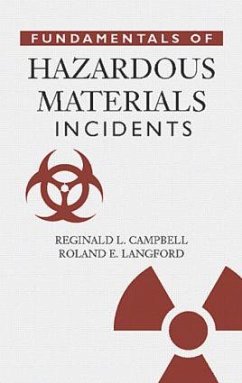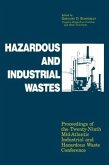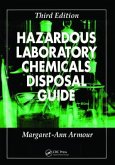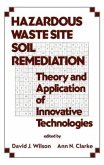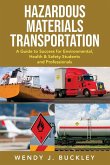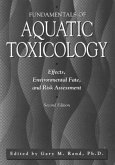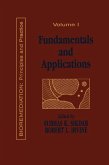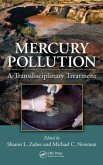- Gebundenes Buch
- Merkliste
- Auf die Merkliste
- Bewerten Bewerten
- Teilen
- Produkt teilen
- Produkterinnerung
- Produkterinnerung
This book evolved from the course developed at the U.S. Department of Labor's National Mine, Health, and Safety Academy to develop the legislation that eventually became 29 CFR 1910.120. Fundamentals of Hazardous Materials Incidents offers the reader a basic understanding of the principles involved in toxicology, federal regulations, respiratory protection, personal protective equipment, radiation, environmental considerations, industrial hygiene sampling, site safety, and chemically resistant suits. Thousands of people have been trained using this manual, now revised and available for the…mehr
Andere Kunden interessierten sich auch für
![Hazardous and Industrial Waste Proceedings, 29th Mid-Atlantic Conference Hazardous and Industrial Waste Proceedings, 29th Mid-Atlantic Conference]() Grego BoardmanHazardous and Industrial Waste Proceedings, 29th Mid-Atlantic Conference354,99 €
Grego BoardmanHazardous and Industrial Waste Proceedings, 29th Mid-Atlantic Conference354,99 €![Hazardous Laboratory Chemicals Disposal Guide Hazardous Laboratory Chemicals Disposal Guide]() Margaret-Ann ArmourHazardous Laboratory Chemicals Disposal Guide348,99 €
Margaret-Ann ArmourHazardous Laboratory Chemicals Disposal Guide348,99 €![Hazardous Waste Site Soil Remediation Hazardous Waste Site Soil Remediation]() David J. WilsonHazardous Waste Site Soil Remediation486,99 €
David J. WilsonHazardous Waste Site Soil Remediation486,99 €![Hazardous Materials Transportation Hazardous Materials Transportation]() Wendy BuckleyHazardous Materials Transportation83,99 €
Wendy BuckleyHazardous Materials Transportation83,99 €![Fundamentals Of Aquatic Toxicology Fundamentals Of Aquatic Toxicology]() Fundamentals Of Aquatic Toxicology193,99 €
Fundamentals Of Aquatic Toxicology193,99 €![Fundamentals and Applications of Bioremediation Fundamentals and Applications of Bioremediation]() Robert L. IrvineFundamentals and Applications of Bioremediation428,99 €
Robert L. IrvineFundamentals and Applications of Bioremediation428,99 €![Mercury Pollution Mercury Pollution]() Mercury Pollution270,99 €
Mercury Pollution270,99 €-
-
-
This book evolved from the course developed at the U.S. Department of Labor's National Mine, Health, and Safety Academy to develop the legislation that eventually became 29 CFR 1910.120. Fundamentals of Hazardous Materials Incidents offers the reader a basic understanding of the principles involved in toxicology, federal regulations, respiratory protection, personal protective equipment, radiation, environmental considerations, industrial hygiene sampling, site safety, and chemically resistant suits. Thousands of people have been trained using this manual, now revised and available for the first time in hardcover format. The book is essential for identifying potential problems at hazardous waste sites, covers diverse topics throughout the area of hazardous materials response, and is ideal for training courses to meet 29 CFR 1910.120 requirements. Quantity discounts available.
Hinweis: Dieser Artikel kann nur an eine deutsche Lieferadresse ausgeliefert werden.
Hinweis: Dieser Artikel kann nur an eine deutsche Lieferadresse ausgeliefert werden.
Produktdetails
- Produktdetails
- Verlag: CRC Press
- Seitenzahl: 472
- Erscheinungstermin: 11. Dezember 1990
- Englisch
- Abmessung: 240mm x 161mm x 30mm
- Gewicht: 869g
- ISBN-13: 9780873713627
- ISBN-10: 0873713621
- Artikelnr.: 23456067
- Herstellerkennzeichnung
- Libri GmbH
- Europaallee 1
- 36244 Bad Hersfeld
- gpsr@libri.de
- Verlag: CRC Press
- Seitenzahl: 472
- Erscheinungstermin: 11. Dezember 1990
- Englisch
- Abmessung: 240mm x 161mm x 30mm
- Gewicht: 869g
- ISBN-13: 9780873713627
- ISBN-10: 0873713621
- Artikelnr.: 23456067
- Herstellerkennzeichnung
- Libri GmbH
- Europaallee 1
- 36244 Bad Hersfeld
- gpsr@libri.de
Mr. Campbell was born in Hartford, Connecticut. His undergraduate degree was from Fairmont State College, Fairmont, West Virginia, and Yale-New Haven Hospital, New Haven, Connecticut. He received his Masters of Science from Marshall University, Huntington, West Virginia. He was an Assistant Professor of Medicine, Hahnemann Medical College of Allied Health Sciences, and instructor of Occupational Health at the U.S. Department of Labor's National Mine Health and Safety Academy, Beckley, West Virginia. He is presently Chief Executive Officer of Campbell Associates, Inc., 533 Suffolk Drive, Sierra Vista, Arizona, a consulting firm specializing in occupational safety and health issues. Mr. Campbell is noted in several biographical references, including Who's Who in the Southwest, Who's Who in the World, and Personalities of the Americas. Dr. Langford was born in Owensboro, Kentucky and grew up in Savannah, Georgia. He received an A.A. from Armstrong State College in 1965, a B.S. in chemistry and physics from Georgia Southern College in 1967, and an M.S. in solution thermodynamics in 1971 and a Ph.D. in physical geochemistry in 1974, both from the University of Georgia under a National Defense Education Act Fellowship. He taught chemistry, geology, environmental chemistry, and physical science at the Savannah Science Museum, Bainbridge College, Georgia Military College, and Georgia Southern College before becoming the Chief of Clinical Chemistry at the U.S. Army Academy of Health Sciences. Following that assignment, Dr. Langford served as a consultant in hazardous waste management at the U.S. Army Environmental Hygiene Agency and then as Commander of the Environmental Sanitation Detachment in Taegu, Korea for the U.S. Army's 5th Preventive Medicine Unit. In Korea, he served as an adjunct faculty member to the University of Maryland. Upon his return to the U.S., he became Chief of Environmental Health at Fort Huachuca, Arizona and Preventive Medicine Officer for the U.S. Army Information Systems Command. Dr. Langford has served as a Judge at the Westinghouse International Science Fair, a member of the review panel for the National Science Foundation's Comprehensive Assistance to Undergraduate Science Education, a member of the scientific review panel for the Hazardous Substances Databank of the National Library of Medicine, and a consultant to the International Union of Operating Engineers. He is a Certified Industrial Hygienist (CIH), Certified Hazardous Materials Specialist (CHMS), Registered Sanitarian (RS), Fellow of the American Institute of Chemists (FAIC), Diplomate of the American Academy of Sanitarians, and Engineer-in-Training (EIT). He is author or coauthor of some twenty papers in thermodynamics, geochemistry, and hazardous materials and is listed in thirteen biographical references, including Who's Who in the World and Who's Who of Emerging Leaders. In 1988, he enrolled at the University of .Nbrlh Carolina - Chapel Hill to work toward a Ph.D. in radiological hygiene.
1. Introduction to Hazardous Materials Incidents
1.1. Purpose
1.2. Development
1.3. To the Student
2. Introduction to Anatomy and Physiology
2.1. Introduction
2.2. Definitions
2.3. Introduction to Anatomy and Physiology
2.4. The Respiratory System
2.5. The Skin
2.6. The Digestive System
2.7. The Nervous System
2.8. The Eyes
2.9. The Reproductive System
2.10. The Endocrine System
2.11. The Blood Circulatory System
2.12. The Lymphatic System
2.13. The Urinary System
2.14. The Liver
2.15. Conclusion
2.16. Chapter Review Questions
3. Introduction to Toxicology
3.1. Introduction
3.2. Definitions
3.3. Health Hazards
3.4. Acute Exposures
3.5. Chronic Exposures
3.6. Toxic Classes
3.7. Poisoning Potential
3.8. Dose Response
3.9;. Animal Models
3.10. Response Curve
3.11. Distribution Curve
3.12. Analytical Limits
3.13. Classes of Chronic Toxins
3.14. Teratogens
3.15. Mutagens
3.16. Carcinogens
3.17. History of Cancer
3.18. Proven Carcinogens
3.19. Classes of Carcinogens
3.20. Fears Versus Real Concerns
3.21. Conclusion
3.22. Chapter Review Questions
4. Hazardous Materials
4.1. Introduction
4.2. Definitions
4.3. Introduction to Chemistry
4.4. Incompatible Chemicals
4.5. Chemical Safety
4.6. Routes of Entry
4.7. Dermal (Skin) Exposure
4.8. Respiratory Exposure
4.9. Digestive Exposure
4.10. Nervous System Exposure
4.11. Ocular (Eye) Exposure
4.12. Effects on Reproduction from Exposure
4.13. Effects on the Endocrine System from Exposure
4.14. Effects on the Circu~tory System from Exposure
4.15. Hepatic (Liver) Effects from Exposure
4.16. Urinary Effects from Exposure
4.17. Industrial Hygiene
4.18. History of Industrial Hygiene
4.19. Conclusion
4.20. Chapter Review Questions
5. Worker Protection
5.1. Introduction
5.2. Definitions
5.3. Occupational Safety and Health Act
5.4. Occupational Safety and Health Administration
5.5. National Institute of Occupational Safety and Health
5.6. OSHA Standards
5.7. NIOSH Recommended Standards
5.8. OSHA General Industry Standards
5.9. OSHA Standards for Construction
5.10. Legal Requirements of Employers
5.11. Legal Requirements of Employees
5.12. Limitations of OSHA Standards
5.13. Hazardous Materials Waming and Identification Systems
5.14. Department of Transportation
5.15. Nuclear Regulatory Commission
5.16. American Conference of Governmental Industrial Hygienists
5.17. National Fire Protection Association
5.18. American National Standards Institute
5.19. International Waming Systems
5.20. International Air Transport Association
5.21. International Maritime Organization
5.22. Limitations of Warning Systems
5.23. Values of Warning Systems
5.24. Conclusion
5.25. Chapter Review Questions
6. Environmental Protection
6.1. Introduction
6.2. Definitions
6.3. Intent of the Resource Conservation and Recovery Act of 1976
6.4. Elements of the Resource Conservation and Recovery Act
6.5. What is a Hazardous Waste?
6.6. Hazardous Waste Identification
6. 7. Standards Applicable to Generators
6.8. Standards Applicable to Transporters
6.9. Standards Applicable to Treatment, Storage, and Disposal Facilities
6.10. Benefits from RCRA
6.11. Comprehensive Environmental Response, Compensation, and Liability Act of 1980
6.12. Superfund Amendments and Reauthorization Act of 1986
6.13. National Priorities List
6.14. Sites Encountered in Cleanup Operations
6.15. Leaking Underground Tanks
6.16. Conclusion
6.17. Chapter Review Questions
7. Hazard Communication and Medical Surveillance
7.1. Introduction
7.2. OSHA Hazard Communication Standard
7.3. Reasons for the Standard
7.4. Relation of MSDSs to SARA
7.5. MSDSs
7.6. Problems with the MSDS
7.7. Value of the MSDS
7.8. Posting of MSDSs
7.9. Elements of a Hazard Communication Program
7.10. Training
7.11. Medical Surveillance
7.12. Preemployment Physical Assessment
7.13. Periodic Physical Examinations
7.14. Biological Exposure Indices®
7.15. Postemployment Physical Examinations
7.16. Occupations Requiring Medical Surveillance
7.17. Conclusion
7.18. Chapter Review Questions
8. Factors Affecting Response /Site Personnel
8.1. Introduction
8.2. Heat
8.3. Cold
8.4. Oxygen Deficiency
8.5. Unusual Factors that Might be Encountered
8.6. Safety Considerations
8.7. Personal Hygiene
8.8. Alcohol and Medication
8.9. The Buddy System
8.10. Response Team Safety Plan
8.11. Communications
8.12. Decontamination
8.13. Conclusion
8.14. Chapter Review Questions
9. Classification of Hazardous Materials
9.1. Introduction
9.2. Hazardous Materials
9.3. Hazardous Waste
9.4. Multiple Hazards
9.5. Classifications of Hazards
9.6. Explosives
9.7. Flammables and Combustibles
9.8. Poisons
9.9. Radioactive Materials
9.10. Corrosive Materials
9.11. Oxidizers
9.12. Etiological Agents
9.13. Irritating Agents
9.14. Organic Peroxides
9.15. Asphyxiants
9.16. Identification of Hazardous Materials
9.17. United Nations Hazard Classes
9.18. Color Coding
9.19. Compressed Gases
Medical
9.20. Compressed Gases
Commercial
9.21. Color Coding of Barrels
9.22. Labels
9.23. Bill of Lading
9.24. Placarding
9.25. National Response Center
9.26. CHEMTREC
9.27. Conclusion
9.28. Chapter Review Questions
10. Incident Command System
10.1. Introduction
10.2. Responsibilities of the Incident Commander
10.3. Incident Command Checklist
10.4. Cessation of Response
10.5. Conclusion
10.6. Chapter Review Questions
11. Personal Protective Clothing and Equipment
11.1. Introduction
11.2. Types of Personal Protective Clothing
11.3. Fire Fighting
11.4. Proximity or Approach Garments
11.5. Flotation Gear
11.6. Blast and Fragmentation Suits
11.7. Antiradiation Suits
11.8. Cooling Gannents
11.9. Chemical
Protective Clothing
11.10. Fully Encapsulating Suits
11.11. Nonencapsulating Suits
11.12. Selection of Protective Clothing
11.13. Permeation
11.14. Durability
11.15. Flexibility
11.16. Temperature
11.17. Ease of Decontamination
11.18. Compatibility with Other Equipment
11.19. Duration
11.20. Levels of Protection
11.21. Level A
11.22. Level B
11.23. Level C
11.24. Level D
11.25. Determination of Level of Protection
11.26. Components and Criteria for Selecting Level A Personal Protective Equipment
11.27. Components and Criteria for Selecting Level B Personal Protective Equipment
11.28. Components and Criteria for Selecting Level C Personal Protective Equipment
11.29. Components and Criteria for Selecting Level D Personal Protective Equipment
11.30. Conclusion
11.31. Chapter Review Questions
12. Pesticide Incidents
12.1. Introduction
12.2. Routes of Entry
12.3. Personal Protective Equipment
12.4. Symptoms of Pesticide Poisoning
12.5. Reactions from Specific Pesticides
12.6. First Aid
12.7. Conclusion
12.8. Chapter Review Questions
13. Equipment Decontamination
13.1. Introduction
13.2. Equipment Maintenance
13.3. Personal Hygiene
13.4. Emergency Repairs
13.5. Maintenance on Contaminated Equipment
13.6. Field Decontamination
13.7. Air Filters /Oil Filters /Engine Oil
13.8. Field Repairs
13.9. Welding
13.10. Tools and Components Used in Field Maintenance
13.11. Powered Hand Tools
13.12. Clean Work Area
13.13. Conclusion
13.14. Chapter Review Questions
14. Radiation and Radioactivity
14.1. Introduction
14.2. Definitions
14.3. Types of Radiation
14.4. Electromagnetic Radiation
14.5. Radioactivity
14.6. Alpha Radiation
14.7. Beta Radiation
14.8. Gamma Radiation
14.9. Neutron Radiation
14.10. Protection from Radiation
14.11. Effects of Ionizing Radiation
14.12. Background Radiation
14.13. Conclusion
14.14. Chapter Review Questions
15. Incident /Site Monitoring
15.1. Introduction
15.2. Rationale for Using Monitoring Equipment
15.3. Utilization of Air
Monitoring Instruments
15.4. General Construction Specifications
15.5. Guidelines for Instrument Usage
15.6. Inherent Safety
15.7. Radiological Monitoring Instruments
15.8. Oxygen
Availability Instruments
15.9. Combustibility
Monitoring Equipment
15.10. Corrosivity Monitoring
15.11. Site Monitoring
15.12. Air Surveillance
15.13. Benefits of Monitoring
15.14. Monitoring Considerations
15.15. Direct
Reading Instruments
15.16. Air
Monitoring Instruments
15.17. Mobile Laboratory
15.18. Periodic Monitoring
15.19. Personal Monitoring
15.20. Types of Personal Monitors
15.21. Gas and Vapor Sampling
15.22. Gas Detectors
15.23. Weather Considerations
15.24. Temperature
15.25. Wind Speed
15.26. Rainfall
15.27. Moisture
15.28. Barometric Pressure
15.29. Weather Watching
15.30. Natural or Biological Hazards
15.31. Conclusion
15.32. Chapter Review Questions
16. Respiratory Protection
16.1. Introduction
16.2. Types of Respirators
16.3. Air
Purifying Respirators
16.4. Powered Air
Purifying Respirators
16.5. Atmosphere
Supplying Respirators
16.6. Self
Contained Breathing Apparatus
16.7. Operational Modes of SCBA
16.8. Operational Limitations of SCBA
16.9. Wearing an SCBA During a Response or on a Site
16.10. Conservation of Air
16.11. Your Air Runs Out!
16.12. Regulator Malfunction
16.13. Egress
16.14. Training
16.15. Medical Examinations
16.16. Respiratory Protection Program
16.17. Conclusion
16.18. Chapter Review Questions
17. Conclusion
References
Appendix A: Information Resources
Appendix B: OSHA Offices
Appendix C: RCRA ''D" Hazardous Wastes (Wastes Listed According to Characteristics)
Appendix D: RCRA "F'' Hazardous Wastes (Wastes Listed According to Source)
Appendix E: RCRA "P" Hazardous Wastes (Extremely Toxic Wastes)
Appendix F: RCRA "U" Hazardous Wastes (Toxic Wastes)
Appendix G: Nuclear Regulatory Commission Offices
Appendix H: The List of Extremely Hazardous Substances and Community Right
to
Know Regulations
Appendix I: 29 CFR Parts 1910, 1915, 1917, 1918, 1926, and 1928: Hazard Communication; Final Rule
Appendix J: 29 CFR Part 1910: Hazardous Waste Operations and Emergency Response; Final Rule
Appendix K: Title m List of Lists
Glossary
Index.
1.1. Purpose
1.2. Development
1.3. To the Student
2. Introduction to Anatomy and Physiology
2.1. Introduction
2.2. Definitions
2.3. Introduction to Anatomy and Physiology
2.4. The Respiratory System
2.5. The Skin
2.6. The Digestive System
2.7. The Nervous System
2.8. The Eyes
2.9. The Reproductive System
2.10. The Endocrine System
2.11. The Blood Circulatory System
2.12. The Lymphatic System
2.13. The Urinary System
2.14. The Liver
2.15. Conclusion
2.16. Chapter Review Questions
3. Introduction to Toxicology
3.1. Introduction
3.2. Definitions
3.3. Health Hazards
3.4. Acute Exposures
3.5. Chronic Exposures
3.6. Toxic Classes
3.7. Poisoning Potential
3.8. Dose Response
3.9;. Animal Models
3.10. Response Curve
3.11. Distribution Curve
3.12. Analytical Limits
3.13. Classes of Chronic Toxins
3.14. Teratogens
3.15. Mutagens
3.16. Carcinogens
3.17. History of Cancer
3.18. Proven Carcinogens
3.19. Classes of Carcinogens
3.20. Fears Versus Real Concerns
3.21. Conclusion
3.22. Chapter Review Questions
4. Hazardous Materials
4.1. Introduction
4.2. Definitions
4.3. Introduction to Chemistry
4.4. Incompatible Chemicals
4.5. Chemical Safety
4.6. Routes of Entry
4.7. Dermal (Skin) Exposure
4.8. Respiratory Exposure
4.9. Digestive Exposure
4.10. Nervous System Exposure
4.11. Ocular (Eye) Exposure
4.12. Effects on Reproduction from Exposure
4.13. Effects on the Endocrine System from Exposure
4.14. Effects on the Circu~tory System from Exposure
4.15. Hepatic (Liver) Effects from Exposure
4.16. Urinary Effects from Exposure
4.17. Industrial Hygiene
4.18. History of Industrial Hygiene
4.19. Conclusion
4.20. Chapter Review Questions
5. Worker Protection
5.1. Introduction
5.2. Definitions
5.3. Occupational Safety and Health Act
5.4. Occupational Safety and Health Administration
5.5. National Institute of Occupational Safety and Health
5.6. OSHA Standards
5.7. NIOSH Recommended Standards
5.8. OSHA General Industry Standards
5.9. OSHA Standards for Construction
5.10. Legal Requirements of Employers
5.11. Legal Requirements of Employees
5.12. Limitations of OSHA Standards
5.13. Hazardous Materials Waming and Identification Systems
5.14. Department of Transportation
5.15. Nuclear Regulatory Commission
5.16. American Conference of Governmental Industrial Hygienists
5.17. National Fire Protection Association
5.18. American National Standards Institute
5.19. International Waming Systems
5.20. International Air Transport Association
5.21. International Maritime Organization
5.22. Limitations of Warning Systems
5.23. Values of Warning Systems
5.24. Conclusion
5.25. Chapter Review Questions
6. Environmental Protection
6.1. Introduction
6.2. Definitions
6.3. Intent of the Resource Conservation and Recovery Act of 1976
6.4. Elements of the Resource Conservation and Recovery Act
6.5. What is a Hazardous Waste?
6.6. Hazardous Waste Identification
6. 7. Standards Applicable to Generators
6.8. Standards Applicable to Transporters
6.9. Standards Applicable to Treatment, Storage, and Disposal Facilities
6.10. Benefits from RCRA
6.11. Comprehensive Environmental Response, Compensation, and Liability Act of 1980
6.12. Superfund Amendments and Reauthorization Act of 1986
6.13. National Priorities List
6.14. Sites Encountered in Cleanup Operations
6.15. Leaking Underground Tanks
6.16. Conclusion
6.17. Chapter Review Questions
7. Hazard Communication and Medical Surveillance
7.1. Introduction
7.2. OSHA Hazard Communication Standard
7.3. Reasons for the Standard
7.4. Relation of MSDSs to SARA
7.5. MSDSs
7.6. Problems with the MSDS
7.7. Value of the MSDS
7.8. Posting of MSDSs
7.9. Elements of a Hazard Communication Program
7.10. Training
7.11. Medical Surveillance
7.12. Preemployment Physical Assessment
7.13. Periodic Physical Examinations
7.14. Biological Exposure Indices®
7.15. Postemployment Physical Examinations
7.16. Occupations Requiring Medical Surveillance
7.17. Conclusion
7.18. Chapter Review Questions
8. Factors Affecting Response /Site Personnel
8.1. Introduction
8.2. Heat
8.3. Cold
8.4. Oxygen Deficiency
8.5. Unusual Factors that Might be Encountered
8.6. Safety Considerations
8.7. Personal Hygiene
8.8. Alcohol and Medication
8.9. The Buddy System
8.10. Response Team Safety Plan
8.11. Communications
8.12. Decontamination
8.13. Conclusion
8.14. Chapter Review Questions
9. Classification of Hazardous Materials
9.1. Introduction
9.2. Hazardous Materials
9.3. Hazardous Waste
9.4. Multiple Hazards
9.5. Classifications of Hazards
9.6. Explosives
9.7. Flammables and Combustibles
9.8. Poisons
9.9. Radioactive Materials
9.10. Corrosive Materials
9.11. Oxidizers
9.12. Etiological Agents
9.13. Irritating Agents
9.14. Organic Peroxides
9.15. Asphyxiants
9.16. Identification of Hazardous Materials
9.17. United Nations Hazard Classes
9.18. Color Coding
9.19. Compressed Gases
Medical
9.20. Compressed Gases
Commercial
9.21. Color Coding of Barrels
9.22. Labels
9.23. Bill of Lading
9.24. Placarding
9.25. National Response Center
9.26. CHEMTREC
9.27. Conclusion
9.28. Chapter Review Questions
10. Incident Command System
10.1. Introduction
10.2. Responsibilities of the Incident Commander
10.3. Incident Command Checklist
10.4. Cessation of Response
10.5. Conclusion
10.6. Chapter Review Questions
11. Personal Protective Clothing and Equipment
11.1. Introduction
11.2. Types of Personal Protective Clothing
11.3. Fire Fighting
11.4. Proximity or Approach Garments
11.5. Flotation Gear
11.6. Blast and Fragmentation Suits
11.7. Antiradiation Suits
11.8. Cooling Gannents
11.9. Chemical
Protective Clothing
11.10. Fully Encapsulating Suits
11.11. Nonencapsulating Suits
11.12. Selection of Protective Clothing
11.13. Permeation
11.14. Durability
11.15. Flexibility
11.16. Temperature
11.17. Ease of Decontamination
11.18. Compatibility with Other Equipment
11.19. Duration
11.20. Levels of Protection
11.21. Level A
11.22. Level B
11.23. Level C
11.24. Level D
11.25. Determination of Level of Protection
11.26. Components and Criteria for Selecting Level A Personal Protective Equipment
11.27. Components and Criteria for Selecting Level B Personal Protective Equipment
11.28. Components and Criteria for Selecting Level C Personal Protective Equipment
11.29. Components and Criteria for Selecting Level D Personal Protective Equipment
11.30. Conclusion
11.31. Chapter Review Questions
12. Pesticide Incidents
12.1. Introduction
12.2. Routes of Entry
12.3. Personal Protective Equipment
12.4. Symptoms of Pesticide Poisoning
12.5. Reactions from Specific Pesticides
12.6. First Aid
12.7. Conclusion
12.8. Chapter Review Questions
13. Equipment Decontamination
13.1. Introduction
13.2. Equipment Maintenance
13.3. Personal Hygiene
13.4. Emergency Repairs
13.5. Maintenance on Contaminated Equipment
13.6. Field Decontamination
13.7. Air Filters /Oil Filters /Engine Oil
13.8. Field Repairs
13.9. Welding
13.10. Tools and Components Used in Field Maintenance
13.11. Powered Hand Tools
13.12. Clean Work Area
13.13. Conclusion
13.14. Chapter Review Questions
14. Radiation and Radioactivity
14.1. Introduction
14.2. Definitions
14.3. Types of Radiation
14.4. Electromagnetic Radiation
14.5. Radioactivity
14.6. Alpha Radiation
14.7. Beta Radiation
14.8. Gamma Radiation
14.9. Neutron Radiation
14.10. Protection from Radiation
14.11. Effects of Ionizing Radiation
14.12. Background Radiation
14.13. Conclusion
14.14. Chapter Review Questions
15. Incident /Site Monitoring
15.1. Introduction
15.2. Rationale for Using Monitoring Equipment
15.3. Utilization of Air
Monitoring Instruments
15.4. General Construction Specifications
15.5. Guidelines for Instrument Usage
15.6. Inherent Safety
15.7. Radiological Monitoring Instruments
15.8. Oxygen
Availability Instruments
15.9. Combustibility
Monitoring Equipment
15.10. Corrosivity Monitoring
15.11. Site Monitoring
15.12. Air Surveillance
15.13. Benefits of Monitoring
15.14. Monitoring Considerations
15.15. Direct
Reading Instruments
15.16. Air
Monitoring Instruments
15.17. Mobile Laboratory
15.18. Periodic Monitoring
15.19. Personal Monitoring
15.20. Types of Personal Monitors
15.21. Gas and Vapor Sampling
15.22. Gas Detectors
15.23. Weather Considerations
15.24. Temperature
15.25. Wind Speed
15.26. Rainfall
15.27. Moisture
15.28. Barometric Pressure
15.29. Weather Watching
15.30. Natural or Biological Hazards
15.31. Conclusion
15.32. Chapter Review Questions
16. Respiratory Protection
16.1. Introduction
16.2. Types of Respirators
16.3. Air
Purifying Respirators
16.4. Powered Air
Purifying Respirators
16.5. Atmosphere
Supplying Respirators
16.6. Self
Contained Breathing Apparatus
16.7. Operational Modes of SCBA
16.8. Operational Limitations of SCBA
16.9. Wearing an SCBA During a Response or on a Site
16.10. Conservation of Air
16.11. Your Air Runs Out!
16.12. Regulator Malfunction
16.13. Egress
16.14. Training
16.15. Medical Examinations
16.16. Respiratory Protection Program
16.17. Conclusion
16.18. Chapter Review Questions
17. Conclusion
References
Appendix A: Information Resources
Appendix B: OSHA Offices
Appendix C: RCRA ''D" Hazardous Wastes (Wastes Listed According to Characteristics)
Appendix D: RCRA "F'' Hazardous Wastes (Wastes Listed According to Source)
Appendix E: RCRA "P" Hazardous Wastes (Extremely Toxic Wastes)
Appendix F: RCRA "U" Hazardous Wastes (Toxic Wastes)
Appendix G: Nuclear Regulatory Commission Offices
Appendix H: The List of Extremely Hazardous Substances and Community Right
to
Know Regulations
Appendix I: 29 CFR Parts 1910, 1915, 1917, 1918, 1926, and 1928: Hazard Communication; Final Rule
Appendix J: 29 CFR Part 1910: Hazardous Waste Operations and Emergency Response; Final Rule
Appendix K: Title m List of Lists
Glossary
Index.
1. Introduction to Hazardous Materials Incidents
1.1. Purpose
1.2. Development
1.3. To the Student
2. Introduction to Anatomy and Physiology
2.1. Introduction
2.2. Definitions
2.3. Introduction to Anatomy and Physiology
2.4. The Respiratory System
2.5. The Skin
2.6. The Digestive System
2.7. The Nervous System
2.8. The Eyes
2.9. The Reproductive System
2.10. The Endocrine System
2.11. The Blood Circulatory System
2.12. The Lymphatic System
2.13. The Urinary System
2.14. The Liver
2.15. Conclusion
2.16. Chapter Review Questions
3. Introduction to Toxicology
3.1. Introduction
3.2. Definitions
3.3. Health Hazards
3.4. Acute Exposures
3.5. Chronic Exposures
3.6. Toxic Classes
3.7. Poisoning Potential
3.8. Dose Response
3.9;. Animal Models
3.10. Response Curve
3.11. Distribution Curve
3.12. Analytical Limits
3.13. Classes of Chronic Toxins
3.14. Teratogens
3.15. Mutagens
3.16. Carcinogens
3.17. History of Cancer
3.18. Proven Carcinogens
3.19. Classes of Carcinogens
3.20. Fears Versus Real Concerns
3.21. Conclusion
3.22. Chapter Review Questions
4. Hazardous Materials
4.1. Introduction
4.2. Definitions
4.3. Introduction to Chemistry
4.4. Incompatible Chemicals
4.5. Chemical Safety
4.6. Routes of Entry
4.7. Dermal (Skin) Exposure
4.8. Respiratory Exposure
4.9. Digestive Exposure
4.10. Nervous System Exposure
4.11. Ocular (Eye) Exposure
4.12. Effects on Reproduction from Exposure
4.13. Effects on the Endocrine System from Exposure
4.14. Effects on the Circu~tory System from Exposure
4.15. Hepatic (Liver) Effects from Exposure
4.16. Urinary Effects from Exposure
4.17. Industrial Hygiene
4.18. History of Industrial Hygiene
4.19. Conclusion
4.20. Chapter Review Questions
5. Worker Protection
5.1. Introduction
5.2. Definitions
5.3. Occupational Safety and Health Act
5.4. Occupational Safety and Health Administration
5.5. National Institute of Occupational Safety and Health
5.6. OSHA Standards
5.7. NIOSH Recommended Standards
5.8. OSHA General Industry Standards
5.9. OSHA Standards for Construction
5.10. Legal Requirements of Employers
5.11. Legal Requirements of Employees
5.12. Limitations of OSHA Standards
5.13. Hazardous Materials Waming and Identification Systems
5.14. Department of Transportation
5.15. Nuclear Regulatory Commission
5.16. American Conference of Governmental Industrial Hygienists
5.17. National Fire Protection Association
5.18. American National Standards Institute
5.19. International Waming Systems
5.20. International Air Transport Association
5.21. International Maritime Organization
5.22. Limitations of Warning Systems
5.23. Values of Warning Systems
5.24. Conclusion
5.25. Chapter Review Questions
6. Environmental Protection
6.1. Introduction
6.2. Definitions
6.3. Intent of the Resource Conservation and Recovery Act of 1976
6.4. Elements of the Resource Conservation and Recovery Act
6.5. What is a Hazardous Waste?
6.6. Hazardous Waste Identification
6. 7. Standards Applicable to Generators
6.8. Standards Applicable to Transporters
6.9. Standards Applicable to Treatment, Storage, and Disposal Facilities
6.10. Benefits from RCRA
6.11. Comprehensive Environmental Response, Compensation, and Liability Act of 1980
6.12. Superfund Amendments and Reauthorization Act of 1986
6.13. National Priorities List
6.14. Sites Encountered in Cleanup Operations
6.15. Leaking Underground Tanks
6.16. Conclusion
6.17. Chapter Review Questions
7. Hazard Communication and Medical Surveillance
7.1. Introduction
7.2. OSHA Hazard Communication Standard
7.3. Reasons for the Standard
7.4. Relation of MSDSs to SARA
7.5. MSDSs
7.6. Problems with the MSDS
7.7. Value of the MSDS
7.8. Posting of MSDSs
7.9. Elements of a Hazard Communication Program
7.10. Training
7.11. Medical Surveillance
7.12. Preemployment Physical Assessment
7.13. Periodic Physical Examinations
7.14. Biological Exposure Indices®
7.15. Postemployment Physical Examinations
7.16. Occupations Requiring Medical Surveillance
7.17. Conclusion
7.18. Chapter Review Questions
8. Factors Affecting Response /Site Personnel
8.1. Introduction
8.2. Heat
8.3. Cold
8.4. Oxygen Deficiency
8.5. Unusual Factors that Might be Encountered
8.6. Safety Considerations
8.7. Personal Hygiene
8.8. Alcohol and Medication
8.9. The Buddy System
8.10. Response Team Safety Plan
8.11. Communications
8.12. Decontamination
8.13. Conclusion
8.14. Chapter Review Questions
9. Classification of Hazardous Materials
9.1. Introduction
9.2. Hazardous Materials
9.3. Hazardous Waste
9.4. Multiple Hazards
9.5. Classifications of Hazards
9.6. Explosives
9.7. Flammables and Combustibles
9.8. Poisons
9.9. Radioactive Materials
9.10. Corrosive Materials
9.11. Oxidizers
9.12. Etiological Agents
9.13. Irritating Agents
9.14. Organic Peroxides
9.15. Asphyxiants
9.16. Identification of Hazardous Materials
9.17. United Nations Hazard Classes
9.18. Color Coding
9.19. Compressed Gases
Medical
9.20. Compressed Gases
Commercial
9.21. Color Coding of Barrels
9.22. Labels
9.23. Bill of Lading
9.24. Placarding
9.25. National Response Center
9.26. CHEMTREC
9.27. Conclusion
9.28. Chapter Review Questions
10. Incident Command System
10.1. Introduction
10.2. Responsibilities of the Incident Commander
10.3. Incident Command Checklist
10.4. Cessation of Response
10.5. Conclusion
10.6. Chapter Review Questions
11. Personal Protective Clothing and Equipment
11.1. Introduction
11.2. Types of Personal Protective Clothing
11.3. Fire Fighting
11.4. Proximity or Approach Garments
11.5. Flotation Gear
11.6. Blast and Fragmentation Suits
11.7. Antiradiation Suits
11.8. Cooling Gannents
11.9. Chemical
Protective Clothing
11.10. Fully Encapsulating Suits
11.11. Nonencapsulating Suits
11.12. Selection of Protective Clothing
11.13. Permeation
11.14. Durability
11.15. Flexibility
11.16. Temperature
11.17. Ease of Decontamination
11.18. Compatibility with Other Equipment
11.19. Duration
11.20. Levels of Protection
11.21. Level A
11.22. Level B
11.23. Level C
11.24. Level D
11.25. Determination of Level of Protection
11.26. Components and Criteria for Selecting Level A Personal Protective Equipment
11.27. Components and Criteria for Selecting Level B Personal Protective Equipment
11.28. Components and Criteria for Selecting Level C Personal Protective Equipment
11.29. Components and Criteria for Selecting Level D Personal Protective Equipment
11.30. Conclusion
11.31. Chapter Review Questions
12. Pesticide Incidents
12.1. Introduction
12.2. Routes of Entry
12.3. Personal Protective Equipment
12.4. Symptoms of Pesticide Poisoning
12.5. Reactions from Specific Pesticides
12.6. First Aid
12.7. Conclusion
12.8. Chapter Review Questions
13. Equipment Decontamination
13.1. Introduction
13.2. Equipment Maintenance
13.3. Personal Hygiene
13.4. Emergency Repairs
13.5. Maintenance on Contaminated Equipment
13.6. Field Decontamination
13.7. Air Filters /Oil Filters /Engine Oil
13.8. Field Repairs
13.9. Welding
13.10. Tools and Components Used in Field Maintenance
13.11. Powered Hand Tools
13.12. Clean Work Area
13.13. Conclusion
13.14. Chapter Review Questions
14. Radiation and Radioactivity
14.1. Introduction
14.2. Definitions
14.3. Types of Radiation
14.4. Electromagnetic Radiation
14.5. Radioactivity
14.6. Alpha Radiation
14.7. Beta Radiation
14.8. Gamma Radiation
14.9. Neutron Radiation
14.10. Protection from Radiation
14.11. Effects of Ionizing Radiation
14.12. Background Radiation
14.13. Conclusion
14.14. Chapter Review Questions
15. Incident /Site Monitoring
15.1. Introduction
15.2. Rationale for Using Monitoring Equipment
15.3. Utilization of Air
Monitoring Instruments
15.4. General Construction Specifications
15.5. Guidelines for Instrument Usage
15.6. Inherent Safety
15.7. Radiological Monitoring Instruments
15.8. Oxygen
Availability Instruments
15.9. Combustibility
Monitoring Equipment
15.10. Corrosivity Monitoring
15.11. Site Monitoring
15.12. Air Surveillance
15.13. Benefits of Monitoring
15.14. Monitoring Considerations
15.15. Direct
Reading Instruments
15.16. Air
Monitoring Instruments
15.17. Mobile Laboratory
15.18. Periodic Monitoring
15.19. Personal Monitoring
15.20. Types of Personal Monitors
15.21. Gas and Vapor Sampling
15.22. Gas Detectors
15.23. Weather Considerations
15.24. Temperature
15.25. Wind Speed
15.26. Rainfall
15.27. Moisture
15.28. Barometric Pressure
15.29. Weather Watching
15.30. Natural or Biological Hazards
15.31. Conclusion
15.32. Chapter Review Questions
16. Respiratory Protection
16.1. Introduction
16.2. Types of Respirators
16.3. Air
Purifying Respirators
16.4. Powered Air
Purifying Respirators
16.5. Atmosphere
Supplying Respirators
16.6. Self
Contained Breathing Apparatus
16.7. Operational Modes of SCBA
16.8. Operational Limitations of SCBA
16.9. Wearing an SCBA During a Response or on a Site
16.10. Conservation of Air
16.11. Your Air Runs Out!
16.12. Regulator Malfunction
16.13. Egress
16.14. Training
16.15. Medical Examinations
16.16. Respiratory Protection Program
16.17. Conclusion
16.18. Chapter Review Questions
17. Conclusion
References
Appendix A: Information Resources
Appendix B: OSHA Offices
Appendix C: RCRA ''D" Hazardous Wastes (Wastes Listed According to Characteristics)
Appendix D: RCRA "F'' Hazardous Wastes (Wastes Listed According to Source)
Appendix E: RCRA "P" Hazardous Wastes (Extremely Toxic Wastes)
Appendix F: RCRA "U" Hazardous Wastes (Toxic Wastes)
Appendix G: Nuclear Regulatory Commission Offices
Appendix H: The List of Extremely Hazardous Substances and Community Right
to
Know Regulations
Appendix I: 29 CFR Parts 1910, 1915, 1917, 1918, 1926, and 1928: Hazard Communication; Final Rule
Appendix J: 29 CFR Part 1910: Hazardous Waste Operations and Emergency Response; Final Rule
Appendix K: Title m List of Lists
Glossary
Index.
1.1. Purpose
1.2. Development
1.3. To the Student
2. Introduction to Anatomy and Physiology
2.1. Introduction
2.2. Definitions
2.3. Introduction to Anatomy and Physiology
2.4. The Respiratory System
2.5. The Skin
2.6. The Digestive System
2.7. The Nervous System
2.8. The Eyes
2.9. The Reproductive System
2.10. The Endocrine System
2.11. The Blood Circulatory System
2.12. The Lymphatic System
2.13. The Urinary System
2.14. The Liver
2.15. Conclusion
2.16. Chapter Review Questions
3. Introduction to Toxicology
3.1. Introduction
3.2. Definitions
3.3. Health Hazards
3.4. Acute Exposures
3.5. Chronic Exposures
3.6. Toxic Classes
3.7. Poisoning Potential
3.8. Dose Response
3.9;. Animal Models
3.10. Response Curve
3.11. Distribution Curve
3.12. Analytical Limits
3.13. Classes of Chronic Toxins
3.14. Teratogens
3.15. Mutagens
3.16. Carcinogens
3.17. History of Cancer
3.18. Proven Carcinogens
3.19. Classes of Carcinogens
3.20. Fears Versus Real Concerns
3.21. Conclusion
3.22. Chapter Review Questions
4. Hazardous Materials
4.1. Introduction
4.2. Definitions
4.3. Introduction to Chemistry
4.4. Incompatible Chemicals
4.5. Chemical Safety
4.6. Routes of Entry
4.7. Dermal (Skin) Exposure
4.8. Respiratory Exposure
4.9. Digestive Exposure
4.10. Nervous System Exposure
4.11. Ocular (Eye) Exposure
4.12. Effects on Reproduction from Exposure
4.13. Effects on the Endocrine System from Exposure
4.14. Effects on the Circu~tory System from Exposure
4.15. Hepatic (Liver) Effects from Exposure
4.16. Urinary Effects from Exposure
4.17. Industrial Hygiene
4.18. History of Industrial Hygiene
4.19. Conclusion
4.20. Chapter Review Questions
5. Worker Protection
5.1. Introduction
5.2. Definitions
5.3. Occupational Safety and Health Act
5.4. Occupational Safety and Health Administration
5.5. National Institute of Occupational Safety and Health
5.6. OSHA Standards
5.7. NIOSH Recommended Standards
5.8. OSHA General Industry Standards
5.9. OSHA Standards for Construction
5.10. Legal Requirements of Employers
5.11. Legal Requirements of Employees
5.12. Limitations of OSHA Standards
5.13. Hazardous Materials Waming and Identification Systems
5.14. Department of Transportation
5.15. Nuclear Regulatory Commission
5.16. American Conference of Governmental Industrial Hygienists
5.17. National Fire Protection Association
5.18. American National Standards Institute
5.19. International Waming Systems
5.20. International Air Transport Association
5.21. International Maritime Organization
5.22. Limitations of Warning Systems
5.23. Values of Warning Systems
5.24. Conclusion
5.25. Chapter Review Questions
6. Environmental Protection
6.1. Introduction
6.2. Definitions
6.3. Intent of the Resource Conservation and Recovery Act of 1976
6.4. Elements of the Resource Conservation and Recovery Act
6.5. What is a Hazardous Waste?
6.6. Hazardous Waste Identification
6. 7. Standards Applicable to Generators
6.8. Standards Applicable to Transporters
6.9. Standards Applicable to Treatment, Storage, and Disposal Facilities
6.10. Benefits from RCRA
6.11. Comprehensive Environmental Response, Compensation, and Liability Act of 1980
6.12. Superfund Amendments and Reauthorization Act of 1986
6.13. National Priorities List
6.14. Sites Encountered in Cleanup Operations
6.15. Leaking Underground Tanks
6.16. Conclusion
6.17. Chapter Review Questions
7. Hazard Communication and Medical Surveillance
7.1. Introduction
7.2. OSHA Hazard Communication Standard
7.3. Reasons for the Standard
7.4. Relation of MSDSs to SARA
7.5. MSDSs
7.6. Problems with the MSDS
7.7. Value of the MSDS
7.8. Posting of MSDSs
7.9. Elements of a Hazard Communication Program
7.10. Training
7.11. Medical Surveillance
7.12. Preemployment Physical Assessment
7.13. Periodic Physical Examinations
7.14. Biological Exposure Indices®
7.15. Postemployment Physical Examinations
7.16. Occupations Requiring Medical Surveillance
7.17. Conclusion
7.18. Chapter Review Questions
8. Factors Affecting Response /Site Personnel
8.1. Introduction
8.2. Heat
8.3. Cold
8.4. Oxygen Deficiency
8.5. Unusual Factors that Might be Encountered
8.6. Safety Considerations
8.7. Personal Hygiene
8.8. Alcohol and Medication
8.9. The Buddy System
8.10. Response Team Safety Plan
8.11. Communications
8.12. Decontamination
8.13. Conclusion
8.14. Chapter Review Questions
9. Classification of Hazardous Materials
9.1. Introduction
9.2. Hazardous Materials
9.3. Hazardous Waste
9.4. Multiple Hazards
9.5. Classifications of Hazards
9.6. Explosives
9.7. Flammables and Combustibles
9.8. Poisons
9.9. Radioactive Materials
9.10. Corrosive Materials
9.11. Oxidizers
9.12. Etiological Agents
9.13. Irritating Agents
9.14. Organic Peroxides
9.15. Asphyxiants
9.16. Identification of Hazardous Materials
9.17. United Nations Hazard Classes
9.18. Color Coding
9.19. Compressed Gases
Medical
9.20. Compressed Gases
Commercial
9.21. Color Coding of Barrels
9.22. Labels
9.23. Bill of Lading
9.24. Placarding
9.25. National Response Center
9.26. CHEMTREC
9.27. Conclusion
9.28. Chapter Review Questions
10. Incident Command System
10.1. Introduction
10.2. Responsibilities of the Incident Commander
10.3. Incident Command Checklist
10.4. Cessation of Response
10.5. Conclusion
10.6. Chapter Review Questions
11. Personal Protective Clothing and Equipment
11.1. Introduction
11.2. Types of Personal Protective Clothing
11.3. Fire Fighting
11.4. Proximity or Approach Garments
11.5. Flotation Gear
11.6. Blast and Fragmentation Suits
11.7. Antiradiation Suits
11.8. Cooling Gannents
11.9. Chemical
Protective Clothing
11.10. Fully Encapsulating Suits
11.11. Nonencapsulating Suits
11.12. Selection of Protective Clothing
11.13. Permeation
11.14. Durability
11.15. Flexibility
11.16. Temperature
11.17. Ease of Decontamination
11.18. Compatibility with Other Equipment
11.19. Duration
11.20. Levels of Protection
11.21. Level A
11.22. Level B
11.23. Level C
11.24. Level D
11.25. Determination of Level of Protection
11.26. Components and Criteria for Selecting Level A Personal Protective Equipment
11.27. Components and Criteria for Selecting Level B Personal Protective Equipment
11.28. Components and Criteria for Selecting Level C Personal Protective Equipment
11.29. Components and Criteria for Selecting Level D Personal Protective Equipment
11.30. Conclusion
11.31. Chapter Review Questions
12. Pesticide Incidents
12.1. Introduction
12.2. Routes of Entry
12.3. Personal Protective Equipment
12.4. Symptoms of Pesticide Poisoning
12.5. Reactions from Specific Pesticides
12.6. First Aid
12.7. Conclusion
12.8. Chapter Review Questions
13. Equipment Decontamination
13.1. Introduction
13.2. Equipment Maintenance
13.3. Personal Hygiene
13.4. Emergency Repairs
13.5. Maintenance on Contaminated Equipment
13.6. Field Decontamination
13.7. Air Filters /Oil Filters /Engine Oil
13.8. Field Repairs
13.9. Welding
13.10. Tools and Components Used in Field Maintenance
13.11. Powered Hand Tools
13.12. Clean Work Area
13.13. Conclusion
13.14. Chapter Review Questions
14. Radiation and Radioactivity
14.1. Introduction
14.2. Definitions
14.3. Types of Radiation
14.4. Electromagnetic Radiation
14.5. Radioactivity
14.6. Alpha Radiation
14.7. Beta Radiation
14.8. Gamma Radiation
14.9. Neutron Radiation
14.10. Protection from Radiation
14.11. Effects of Ionizing Radiation
14.12. Background Radiation
14.13. Conclusion
14.14. Chapter Review Questions
15. Incident /Site Monitoring
15.1. Introduction
15.2. Rationale for Using Monitoring Equipment
15.3. Utilization of Air
Monitoring Instruments
15.4. General Construction Specifications
15.5. Guidelines for Instrument Usage
15.6. Inherent Safety
15.7. Radiological Monitoring Instruments
15.8. Oxygen
Availability Instruments
15.9. Combustibility
Monitoring Equipment
15.10. Corrosivity Monitoring
15.11. Site Monitoring
15.12. Air Surveillance
15.13. Benefits of Monitoring
15.14. Monitoring Considerations
15.15. Direct
Reading Instruments
15.16. Air
Monitoring Instruments
15.17. Mobile Laboratory
15.18. Periodic Monitoring
15.19. Personal Monitoring
15.20. Types of Personal Monitors
15.21. Gas and Vapor Sampling
15.22. Gas Detectors
15.23. Weather Considerations
15.24. Temperature
15.25. Wind Speed
15.26. Rainfall
15.27. Moisture
15.28. Barometric Pressure
15.29. Weather Watching
15.30. Natural or Biological Hazards
15.31. Conclusion
15.32. Chapter Review Questions
16. Respiratory Protection
16.1. Introduction
16.2. Types of Respirators
16.3. Air
Purifying Respirators
16.4. Powered Air
Purifying Respirators
16.5. Atmosphere
Supplying Respirators
16.6. Self
Contained Breathing Apparatus
16.7. Operational Modes of SCBA
16.8. Operational Limitations of SCBA
16.9. Wearing an SCBA During a Response or on a Site
16.10. Conservation of Air
16.11. Your Air Runs Out!
16.12. Regulator Malfunction
16.13. Egress
16.14. Training
16.15. Medical Examinations
16.16. Respiratory Protection Program
16.17. Conclusion
16.18. Chapter Review Questions
17. Conclusion
References
Appendix A: Information Resources
Appendix B: OSHA Offices
Appendix C: RCRA ''D" Hazardous Wastes (Wastes Listed According to Characteristics)
Appendix D: RCRA "F'' Hazardous Wastes (Wastes Listed According to Source)
Appendix E: RCRA "P" Hazardous Wastes (Extremely Toxic Wastes)
Appendix F: RCRA "U" Hazardous Wastes (Toxic Wastes)
Appendix G: Nuclear Regulatory Commission Offices
Appendix H: The List of Extremely Hazardous Substances and Community Right
to
Know Regulations
Appendix I: 29 CFR Parts 1910, 1915, 1917, 1918, 1926, and 1928: Hazard Communication; Final Rule
Appendix J: 29 CFR Part 1910: Hazardous Waste Operations and Emergency Response; Final Rule
Appendix K: Title m List of Lists
Glossary
Index.

